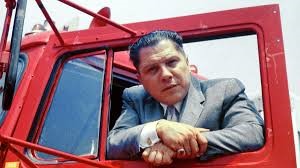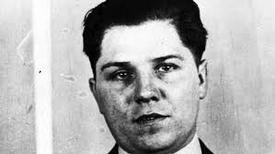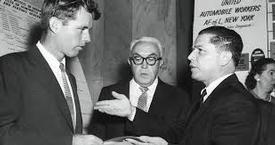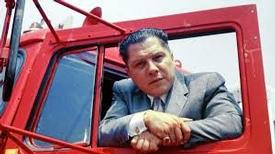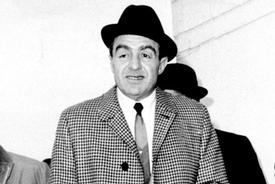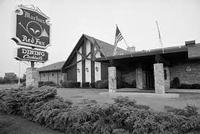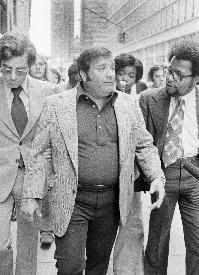On the scorching hot afternoon of Wednesday, 30th July 1975, 62-year-old Jimmy Hoffa lay sleeping outside his cottage in Lake Orion, 40 miles north of Detroit. He needed all the rest he could get. The former union boss, once the most powerful labour leader in the United States, had endured a humiliating prison sentence but was now a free man again and plotting his return to power.
Just after 1 O’clock, his wife Josephine woke him up. He was due to have a lunch meeting with two men with a view to securing their support in his upcoming battle to re-claim his position as President of the mighty Teamsters’ union of American truck drivers. Though he was technically still banned from associating with the union until 1980, rumours were swirling that the federal government was about to give in to his demands that those restrictions be lifted. He kissed his wife twice before jumping into his dark green car and driving away. Josephine would later comment that she was unnerved as he left – he never kissed her twice. She was sure Jimmy was worried about something.
If Jimmy Hoffa was nervous as he headed out to lunch that afternoon, he had good reason to be. The two men he was due to meet, Anthony Giacalone and Anthony Provenzano, were powerful figures in the Detroit and New Jersey mafia respectively, and Hoffa had an uneasy relationship with Provenzano in particular. Hoffa had blundered into the world of organised crime when looking for support in his battle against unscrupulous industry bosses and had never been able to wriggle free of the mafia’s influence. For a time he had no qualms about being involved with them, but as he sought their support in his battle to re-claim his power he increasingly suspected that the mafia saw him as expendable.
After his release from prison in 1971, Hoffa could have retired comfortably. But once a man like him had a taste of the awesome power he had enjoyed as a union boss he could never let it go. His desire to re-claim that power would seal his fate.
Working Class Hero
James Riddle Hoffa was born on 14th February 1913, the son of a coal miner in Indiana. When his father died in 1924, his mother moved the family to Detroit and by the age of 14 Hoffa had quit school and worked in several manual jobs for the rest of the 1920s. The environment that Hoffa worked in was one of poor conditions and paltry pay, with little chance of workers organising to improve their conditions. Industry bosses would employ local police or, more often, gangs of local thugs to intimidate and beat any workers who attempted to organise a strike. The teenaged Hoffa quickly developed an animosity for those bosses and a sense of solidarity with his fellow workers.
The 1929 economic collapse led to mass unemployment, which in turn made it even harder for those who still had a job to strike for better conditions. Despite the election of President Franklin Roosevelt which ushered in pro-union laws, the fact remained that striking workers could easily be replaced by masses of unemployed people who were desperate for work.
This context makes Jimmy Hoffa’s actions aged 19 all the more stunning. In 1932 he was working for a food distribution company and organised his fellow workers to refuse to unload a delivery of strawberries, which needed to be placed in ice to prevent spoilage, until their modest demands were met. The bosses quickly folded, and Hoffa had made a name for himself as a promising union organiser.
The young Jimmy Hoffa did not shirk from a fight
By the mid-1930s, Hoffa’s ‘strawberry boys’ were not only admitted to the Teamsters’ Union, but Hoffa himself was appointed to a senior role. Still only in his early 20s, Hoffa already had a fairly rotund figure and stood at just 5’5, but it was his tough negotiating skills and willingness to fight tooth and nail for his fellow workers that made him an instant hero among the teamsters.
Hoffa still operated in an environment that was hostile to unions and became increasingly so with the onset of the cold war in the late 1940s. At this time, union organising was still a radical activity and seen as dangerously close to communism, but Hoffa’s sheer passion and relentless pitches to individual truck drivers inspired a huge boom in union membership. Hoffa played a huge part in securing pay increases and other benefits for his workers, and he was adored for it.
Legal Troubles
In 1952, Hoffa was selected as a Vice-President in the union, but trouble was brewing on the horizon. A congressional committee had been established to investigate corruption and the influence of organised crime in American unions, headed by Arkansas senator John McClellan. The committee made light work of Teamsters’ President Dave Beck, whose career was finished after his repeated use of the 5th amendment (giving him the right to remain silent), but found Hoffa a tougher nut to crack. Sitting on the committee was Massachusetts Senator John F Kennedy, whose younger brother Robert was providing legal counsel for the panel. The younger Kennedy developed a fixation with Hoffa and was determined to incriminate him, but Hoffa’s combative style under questioning easily dealt with the young lawyer’s questions. For his part, Hoffa developed a strong dislike for the Kennedy brothers, who he saw as spoiled rich kids who had conveniently forgotten how their own father, Joe Kennedy, had ties to the mafia.
President of the Teamsters Union
The McClellan hearings were televised and brought in an audience of over a million viewers. Working-class viewers loved Hoffa for the fact that he had so clearly infuriated the elite politicians who had hauled him before the committee, and he was elected President of the Teamsters’ union in a landslide later that year.
The McClellan hearings may have made Hoffa popular, but they had exposed evidence that he had deep ties to the mafia. He had first enlisted their help as he tried to fight off the thugs hired by industry bosses to break strikes in the 1930s and 1940s, and by the time he became the union boss he was allowing the mafia to access the nearly billion dollar union pension fund. The mob primarily used this money to build and operate casinos in Las Vegas.
In November 1960 Hoffa was struck a blow when John F Kennedy, older brother of his nemesis Robert Kennedy, was elected President. Robert Kennedy was appointed to the post of Attorney General and made organised crime and corrupt labour unions his top priority. He even assembled a ‘Get Hoffa’ squad, intent on finding something to throw Hoffa in prison for.
Hoffa remained popular with both the workforce and business bosses – he was still a hero to the average workers and lived a modest lifestyle among them with his wife and children in Detroit, but business leaders knew he had a liberal attitude to supplying kickbacks and contracts to anyone who could provide the right amount of money. Union membership was nearly 2 million by the mid-1960s and the coffers had never been so full, but an increasing amount of money was having to be spent on fighting his legal troubles. The assassination of President Kennedy in 1963 provided a welcome relief for Hoffa as it meant Bobby Kennedy stood to lose most of his power, but the grief-stricken Attorney General managed to pull together a final effort to get his man.
Conviction, prison and release
In March 1964, Jimmy Hoffa was convicted of jury-tampering, and then received a further conviction for the misuse of pension funds that July. He appealed the convictions all the way until 1967, before finally submitting to his 13-year prison sentence. During his incarceration he became acquainted with fellow inmate Tony Provenzano, a captain in the Genovese mafia family, but the two had a falling out after Provenzano judged that Hoffa was backing other mafia families over his. The feud likely cost Hoffa his life.
Hoffa remained as Teamster boss from inside the prison until he got wind that President Richard Nixon, who he had backed over Kennedy in 1960, would be willing to give him a pardon if he abstained from union activity until 1980. Hoffa jumped at the opportunity and was released from prison in 1971, but if he did have genuine intentions of keeping to the agreement they did not last for long. He engineered the ascension of his close associate, Frank Fitzsimmons, to the presidency of the union and so was still running things even though he was not officially associated with it. Pushing his luck further, he agitated to return in an official capacity and launched a lawsuit against the government that had given him a pardon, arguing that his prohibition from union activity was unlawful.
Disappearance
By the summer of 1975, it looked as if Hoffa was going to get his way. But the mafia figures he had been so closely associated with were not as keen on the idea as Hoffa had hoped. For a start, they decided they could do without the controversy and baggage that Hoffa brought. He may have been safe from prosecution in 1975 but there was an election due the following year and the mob feared that a new President could go after Hoffa again. Secondly, they had come to enjoy their relationship with Fitzsimmons, a weak-minded man who they found far easier to control than the brash and outspoken Hoffa. Fitzsimmons had been placed in his position by Hoffa precisely because of his weak-mindedness, but it now appeared that the move had backfired spectacularly. So it was that Jimmy Hoffa organised a lunch meet with Tony Giacalone and Tony Provenzano that fateful afternoon in July 1975, hoping to smooth things over and secure their support.
Hoffa arrived at the designated meeting place, the Machus Red Fox restaurant in Bloomfield township, just outside of Detroit, just after 2 O’clock on 30th July. He waited outside the restaurant before calling his wife at 2:15 to complain that no one had arrived, and mentioned that he would be home by 4 O’clock to grill steaks for dinner. He then made a further call to his associate Louis Linteau. After that, Jimmy Hoffa simply vanished.
The Machus Red Fox restaurant, where Hoffa was last seen
Josephine Hoffa, who had been unnerved when her husband kissed her twice before he left, began to panic when he did not arrive home that evening. The next morning she phoned her children, who immediately joined her in Lake Orion and began tracing their father’s last known movements. His car was found outside the restaurant, with no sign of a struggle and the driver’s door unlocked. That evening, they officially reported him missing to the police.
Theories
Jimmy Hoffa had been a household name not just in the US but across the entire world, and news of his disappearance spread rapidly. The FBI were called to assist the Michigan state police and despite the Hoffa family’s hope that he had only been kidnapped to scare him or to secure a ransom, professional investigators were fairly certain from the very start that they were dealing with a murder investigation. They immediately moved to question Giacalone and Provenzano, but both men had airtight alibies for their whereabouts that afternoon – suspiciously airtight, as if they had been making sure they were seen by as many witnesses as possible away from Detroit.
On Tuesday 5th August 1975, the Hoffa family offered a reward of $200,000 for information regarding Jimmy’s whereabouts. Sure enough, the tips started streaming in, but none of them led anywhere. One of the more outlandish theories suggested that Hoffa had been killed and buried underneath Giants’ stadium in New Jersey, which was being built at the time. One person even called and declared that he had seen a vision of Hoffa in a prison in south America.
The most reasonable theories centre on the role of Chuckie O’Brien. Hoffa had been in a relationship with O’Brien’s mother, Sylvia Pagano, before he married Josephine. Sylvia had gone on to marry a man named Frank O’Brien, who died young. Hoffa took the O’Brien family into his home and provided a father figure to Chuckie, who came to regard Hoffa’s children James Jr and Barbara as his siblings. Numerous witnesses reported seeing O’Brien outside the restaurant and the week after the disappearance he admitted that he was in the Detroit area on 30th July driving a car borrowed from Tony Giacalone’s son. Investigators confiscated the car and found blood in the back seat, but O’Brien claimed he was transporting a salmon for his friend. The blood was tested and found not to be human blood, but even O’Brien’s excuse brought more suspicion – ‘sleeping with the fishes’ is well known mafia code for someone being killed and dumped at sea. Later, investigators found Jimmy Hoffa’s hair in the car, but since it could not be proven when Hoffa had been in the car no charges resulted from it.
Hoffa's stepson, Chuckie O'Brien, maintained that he had nothing to do with the disappearance
In September 1975, a federal grand jury was assembled in Detroit. The men called to testify before it included top Teamster officials and known mafia members, including O’Brien, Giacalone and Provenzano, who all pleaded the 5th amendment and remained silent. Informants then pointed the finger at three men as the abductors of Jimmy Hoffa: Salvatore Briguglio, a close associate of Tony Provenzano, his brother Gabriel Briguglio, and Thomas Andretta. All three were hauled before the jury, but in December the jury was disbanded with no charges brought against anyone.
In 1982, seven years after he disappeared, Jimmy Hoffa was declared legally dead. Since his body has never been found, theories about his demise continue to be put forward to this day. Most recently, Martin Scorsese’s 2019 film The Irishman leans on the claims of Frank Sheehan, a known hitman for the Philadelphia mafia, that he killed Hoffa in a house in suburban Detroit after he was abducted.
This theory is probably not far off what actually happened. While Sheehan's claims of being the gunman are not taken too seriously by most theorists, it is likely that Hoffa was lured to a house or another location away from the restaurant, having been reassured by the presence of his stepson, Chuckie O’Brien. It is probable that O’Brien was brought along for this exact reason and had no idea about the plan to murder Hoffa. As Josephine Hoffa waited for her husband at around 4 that afternoon, Jimmy was likely already dead, killed almost as soon as he arrived at the pre-determined location and his body disposed of somehow.
Jimmy Hoffa had lived a colourful life and his legacy is a mixed one. Corrupt though he was, he certainly earned his place as a phenomenal union organiser and delivered brilliant benefits for his workers. If he were around to defend his record today, he would no doubt argue that his dealings with the mob were necessary in order to deliver those benefits – if he admitted to having such dealings in the first place. Whether those mafia ties were justified or not, they almost certainly led him to an early grave; a grave that as yet has never been found.
Acknowledgements
The Ministry of History is not an academic source. Our pieces are written by writers who have been keen students of history for years and are well versed in, and influenced by, countless other writers and works. For this article specifically our sources have included:
'What happened to Jimmy Hoffa?', article by Tim Ott, published by biography.com (2019)
'The true story behind what happened to Jimmy Hoffa', article by Rachel Askinasi, published by businessinsider.com (2020)
'The story of Jimmy Hoffa's dangerous life and mysterious death that The Irishman left out', article byDom Nero, published by Esquire.com (2019)
Images
Image one - allthatsinteresting.com
Image two - clickondetroit.com
Image three - wsj.com
Image four - oxygen.com
Image five - pintrest.co.uk
Image six - nytimes.com

